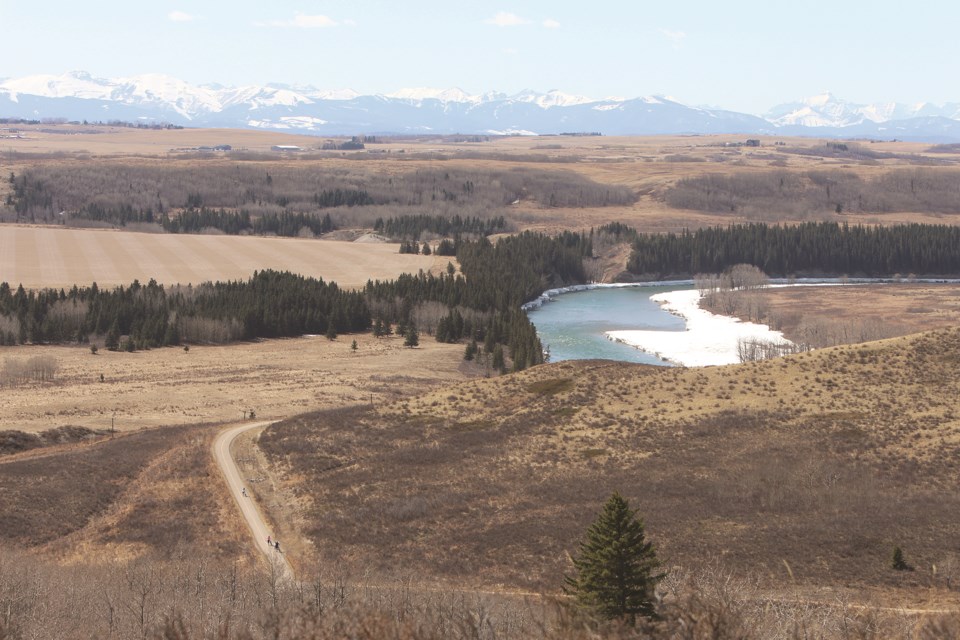With public consultation and field studies on the horizon, the Glenbow Ranch Park Foundation (GRPF) is continuing to voice its opposition to a proposed reservoir project that would be located in the east end of the provincial park.
GRPF, which oversees and manages Glenbow Ranch Provincial Park, first issued a letter of opposition to the Alberta government’s consideration of the reservoir project in 2019, and re-issued the letter in an email to stakeholders earlier this month.
According to an Alberta government breakdown of the project, the large-scale dam project aims to mitigate the impact of flood and drought on Calgary and its downstream communities. A spot near Glenbow Ranch Provincial Park is proposed as one of three potential locations for the reservoir, called the Glenbow East Reservoir option. The other two options are located upstream along the Bow River, near Ghost Lake and Morley.
“Alberta Environment and Parks continues to explore options to build additional flood and drought storage capacity on the Bow River to reduce the impacts of severe weather events on Albertans and the economy,” stated an information page on the government's website.
According to Sarah Parker, executive director of GRPF, the foundation’s main opposition to the project stems from the potential ecological impact of the reservoir, decreased recreation opportunities and possible destruction of cultural and historical sites. She said the dam would, in effect, flood a large portion of the park’s low-lying areas during times of high waterflow. Glenbow Ranch Provincial Park is located near the Bow River, just southeast of Cochrane.
“What makes our park incredibly unique in Alberta is that we protect about 3,200 acres of fescue grass lands,” she said. “There’s only about 15 per cent of fescue grass lands left in the province.
“So, to ruin that incredibly fragile and disappearing ecosystem, right off the bat we’re opposed to [this project]. We have a lot of species at risk in the park and they would all be threatened by this project.”
The Alberta Government’s Bow River Basin Reservoir Options project team completed Phase 1 of the project in the spring of 2020, developing a conceptual assessment. Phase 2, which is currently underway, includes a long-term feasibility study, and is estimated to near completion in spring 2023.
“The feasibility study will continue to examine the flood and drought mitigation reservoir options identified in the conceptual assessment, with a focus on determining the technical feasibility of the three options, as well as identifying the potential impacts and associated benefits, implementation requirements and costs of each reservoir option,” the government's page stated.
The study will be followed by a third phase, according to the government's breakdown of the project, which includes engineering and regulatory processes. Finally, Phase 4 would include procurement, construction, and commissioning of funding and services.
Parker stated a lot of the at-risk species found in the park would be threatened by the proposed dam project. She claimed the ecological richness of Glenbow Ranch Provincial Park would be in jeopardy, along with the resulting destruction of several historical and cultural sites at the park.
“We also have about 26 Indigenous archeological sites that would be flooded, as well as some of our pathways,” she said. “We’re concerned about some of the human health impacts from a project of this size.
“As well, the tax dollars that would go into this option would be astronomical compared to some of the other options and we just don’t see how it could be a good idea.”
Parker added that the Canadian Pacific Rail line that runs through the park would have to be uprooted to another location to make the dam project feasible.
“There’s just a lot of complications that make us believe that this option is just a bad one,” she said.
Since a devastating flood in Alberta in 2013, the Province has been investigating various flood and drought mitigation options, including the creation of reservoirs that would hold water during times of drought or flooding.
“We are not in the flood mitigation game,” Parker said. “All we know is the impact this would have on our park, which would go against the entire point of this park existing.”
Parker added the project is not set in stone and there is still time for visitors to the park to have “your voices heard.”
As part of the feasibility study, Phase 2 of the project includes engagement opportunities for Indigenous groups, stakeholders and other members of the public. This includes opportunities to submit feedback directly to the Bow Basin project team at [email protected]. There will also be several virtual open houses for people to take part in, including sessions on June 22, 24 and 26.
Parker said she encourages people to take part in the public consultations taking place this month.
“Whether you’re concerned about diminishing trails in the park, whether you’re concerned about habitat for deer or bees or simply think that there are better options out there, you need to let your voice be known now,” she said.
“We’re hoping that the feedback from the public and from environmental organizations and from Indigenous groups is truly heard and that nothing clouds the government’s judgment in choosing the truly best option.”
To read the official letter of opposition from GRPF please visit bit.ly/2SI5B3h. To learn more about the Bow River reservoir project, visit bit.ly/3q2rE0W. The page includes various data collected during Phase 1, including geotechnical drilling and geological field mapping, geophysical surveys, environmental fieldwork and topographical surveys.
In an email statement, Alberta Environment and Parks representatives for the project stated that three reservoir options are being considered and engagement with public, stakeholders, and Indigenous groups is underway.
“As the feasibility study proceeds over the next two years, the planned technical discussions with GRPF are intended to achieve a better understanding of the potential impacts on GRPF infrastructure and operations, including possible mitigation measured that could reduce these impacts,” the statement read.
Carmen Cundy, AirdrieToday.com
Follow me on Twitter @carmenrcundy




